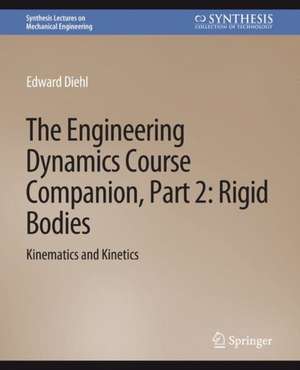The Engineering Dynamics Course Companion, Part 2: Rigid BodiesKinematics and Kinetics: Synthesis Lectures on Mechanical Engineering
Autor Edward Diehlen Limba Engleză Paperback – 30 sep 2020
Din seria Synthesis Lectures on Mechanical Engineering
-
 Preț: 396.31 lei
Preț: 396.31 lei - 18%
 Preț: 577.56 lei
Preț: 577.56 lei -
 Preț: 328.08 lei
Preț: 328.08 lei -
 Preț: 199.35 lei
Preț: 199.35 lei -
 Preț: 197.44 lei
Preț: 197.44 lei -
 Preț: 326.17 lei
Preț: 326.17 lei - 15%
 Preț: 526.35 lei
Preț: 526.35 lei - 15%
 Preț: 525.54 lei
Preț: 525.54 lei -
 Preț: 207.83 lei
Preț: 207.83 lei -
 Preț: 321.34 lei
Preț: 321.34 lei -
 Preț: 393.52 lei
Preț: 393.52 lei -
 Preț: 320.20 lei
Preț: 320.20 lei -
 Preț: 320.40 lei
Preț: 320.40 lei -
 Preț: 488.33 lei
Preț: 488.33 lei -
 Preț: 383.72 lei
Preț: 383.72 lei -
 Preț: 224.65 lei
Preț: 224.65 lei - 19%
 Preț: 453.48 lei
Preț: 453.48 lei -
 Preț: 225.79 lei
Preț: 225.79 lei -
 Preț: 279.81 lei
Preț: 279.81 lei - 19%
 Preț: 448.41 lei
Preț: 448.41 lei - 19%
 Preț: 459.83 lei
Preț: 459.83 lei -
 Preț: 416.01 lei
Preț: 416.01 lei - 19%
 Preț: 451.30 lei
Preț: 451.30 lei - 19%
 Preț: 478.36 lei
Preț: 478.36 lei -
 Preț: 413.45 lei
Preț: 413.45 lei -
 Preț: 225.71 lei
Preț: 225.71 lei -
 Preț: 351.41 lei
Preț: 351.41 lei -
 Preț: 383.12 lei
Preț: 383.12 lei -
 Preț: 415.24 lei
Preț: 415.24 lei -
 Preț: 260.18 lei
Preț: 260.18 lei -
 Preț: 416.01 lei
Preț: 416.01 lei -
 Preț: 452.40 lei
Preț: 452.40 lei -
 Preț: 448.21 lei
Preț: 448.21 lei -
 Preț: 390.25 lei
Preț: 390.25 lei -
 Preț: 225.56 lei
Preț: 225.56 lei -
 Preț: 166.82 lei
Preț: 166.82 lei - 19%
 Preț: 447.03 lei
Preț: 447.03 lei -
 Preț: 457.72 lei
Preț: 457.72 lei - 19%
 Preț: 458.39 lei
Preț: 458.39 lei -
 Preț: 459.02 lei
Preț: 459.02 lei - 19%
 Preț: 441.30 lei
Preț: 441.30 lei - 19%
 Preț: 442.75 lei
Preț: 442.75 lei -
 Preț: 415.24 lei
Preț: 415.24 lei -
 Preț: 191.31 lei
Preț: 191.31 lei -
 Preț: 180.41 lei
Preț: 180.41 lei -
 Preț: 226.56 lei
Preț: 226.56 lei -
 Preț: 386.31 lei
Preț: 386.31 lei -
 Preț: 383.72 lei
Preț: 383.72 lei
Preț: 487.75 lei
Nou
Puncte Express: 732
Preț estimativ în valută:
93.36€ • 101.44$ • 78.47£
93.36€ • 101.44$ • 78.47£
Carte tipărită la comandă
Livrare economică 21 aprilie-05 mai
Preluare comenzi: 021 569.72.76
Specificații
ISBN-13: 9783031796807
ISBN-10: 3031796802
Pagini: 217
Ilustrații: XIII, 217 p.
Dimensiuni: 191 x 235 mm
Greutate: 0.42 kg
Editura: Springer International Publishing
Colecția Springer
Seria Synthesis Lectures on Mechanical Engineering
Locul publicării:Cham, Switzerland
ISBN-10: 3031796802
Pagini: 217
Ilustrații: XIII, 217 p.
Dimensiuni: 191 x 235 mm
Greutate: 0.42 kg
Editura: Springer International Publishing
Colecția Springer
Seria Synthesis Lectures on Mechanical Engineering
Locul publicării:Cham, Switzerland
Cuprins
Acknowledgments.- Introduction.- Angular Kinematics of Rigid Body Motion.- Absolute and Relative Velocity.- Velocity Analysis Using the Instantaneous Center of Rotation.- Acceleration Analysis (Part\nobreakspace {.- Acceleration Analysis (Part\nobreakspace {.- Coriolis Acceleration Analysis.- Mass Moment of Inertia.- Newton's Second Law in Constrained Plane Motion.- Energy Methods.- Rigid Body Impulse-Momentum Method.- Impact of Rigid Bodies.- Author's Biography .
Notă biografică
Dr. Edward Diehl obtained his doctoral degree in Mechanical Engineering from the University of Connecticut in December 2016. He is currently an Assistant Professor at the University of Hartford in the Mechanical Engineering Department. Prior to joining UHartford, he was a lecturer (2009–2017) at the United States Coast Guard Academy in both the Mechanical Engineering section and Naval Architecture and Marine Engineering section. He worked as a Principal Engineer (2006–2009, 1996–2000, and 1992–1995) for Seaworthy Systems, Inc., self-employed (2000–2006), and an analyst (1995–1996) for General Dynamics/Electric Boat. He is a registered Professional Engineer in Connecticut. He obtained a Master of Science in Mechanical Engineering from Rensselaer at Hartford in 1996. He is a proud graduate of the United States Merchant Marine Academy at Kings Point, class of 1992, with a Bachelor of Science degree in Marine Engineering Systems. His research interests include solid mechanics pedagogy, gear vibration and fault modeling, and mechanism design.
